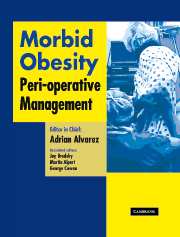Book contents
- Frontmatter
- Contents
- Contributors
- Foreword
- Preface
- Acknowledgments
- Dedication
- Section 1 General aspects
- Section 2 Pathophysiology
- 4 Lung physiology
- 5 Cardiac morphology and ventricular function
- 6 Pathophysiology of cardiovascular co-morbidities
- 7 Physiological changes during laparoscopy
- 8 Digestive physiology and gastric aspiration
- Section 3 Pre-operative management
- Section 4 Peri-operative management of co-morbidities
- Section 5 Pharmacology
- Section 6 Monitoring
- Section 7 Intra-operative management
- Section 8 Post-operative care
- Section 9 Conclusions
- Afterword
- Index
5 - Cardiac morphology and ventricular function
from Section 2 - Pathophysiology
Published online by Cambridge University Press: 17 August 2009
- Frontmatter
- Contents
- Contributors
- Foreword
- Preface
- Acknowledgments
- Dedication
- Section 1 General aspects
- Section 2 Pathophysiology
- 4 Lung physiology
- 5 Cardiac morphology and ventricular function
- 6 Pathophysiology of cardiovascular co-morbidities
- 7 Physiological changes during laparoscopy
- 8 Digestive physiology and gastric aspiration
- Section 3 Pre-operative management
- Section 4 Peri-operative management of co-morbidities
- Section 5 Pharmacology
- Section 6 Monitoring
- Section 7 Intra-operative management
- Section 8 Post-operative care
- Section 9 Conclusions
- Afterword
- Index
Summary
Introduction
Obesity produces a variety of hemodynamic alterations that affect cardiac morphology and ventricular function. These alterations occur in persons with mild-to-moderate obesity, but are most pronounced in those with morbid obesity. This chapter discusses the hemodynamic changes that occur with mild, moderate and morbid obesity, reviews their impact of cardiac morphology and ventricular function, describes the clinical syndrome of obesity cardiomyopathy and discusses the effects of weight loss on these alterations. These changes in cardiac structure and function may have important implications for anesthesiologists concerning the choice of anesthesia and peri-operative care of the surgical patient.
Classification of obesity
The World Health Organization classifies obesity in terms of body mass index (BMI). The classifications are as follows: lean or normal range (18.5–24.9kg/m2); pre-obese or overweight (25.0–29.9 kg/m2); mild or class I obesity (30.0–34.9 kg/m2); moderate or class II obesity (35.0–39.9 kg/m2); and morbid or class III obesity (≥40.0 kg/m2). Many of the studies cited in this review used this classification system. However, some of the studies used different criteria for obesity and morbid obesity. Obesity was defined by some as ≥20% over ideal body weight or relative weight ≥120%. Morbid obesity was defined by some as ≥twice ideal body weight or relative weight ≥200%.
- Type
- Chapter
- Information
- Morbid ObesityPeri-Operative Management, pp. 59 - 68Publisher: Cambridge University PressPrint publication year: 2004

